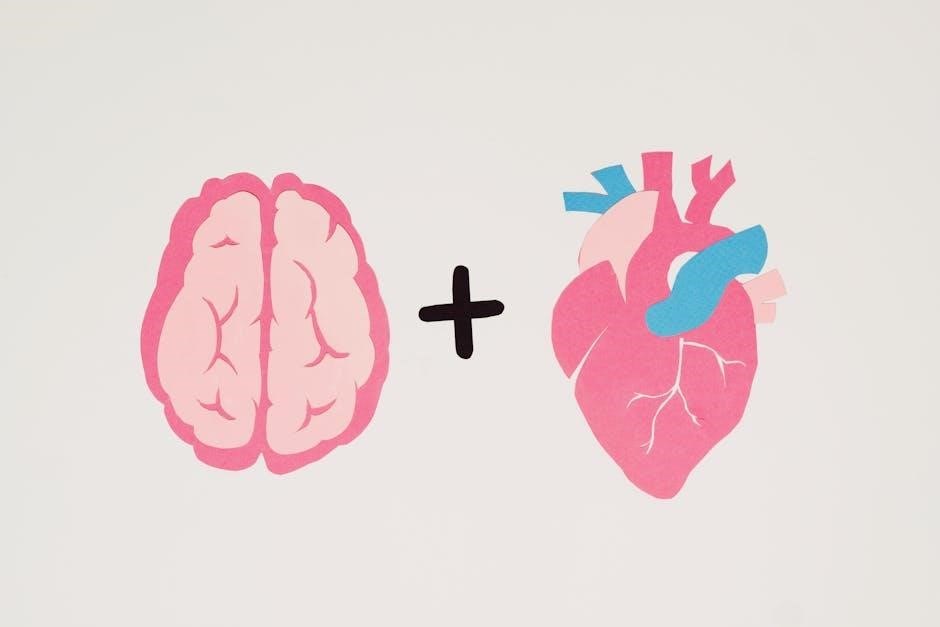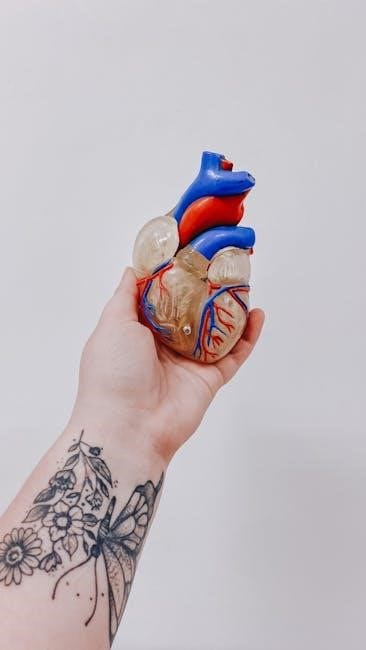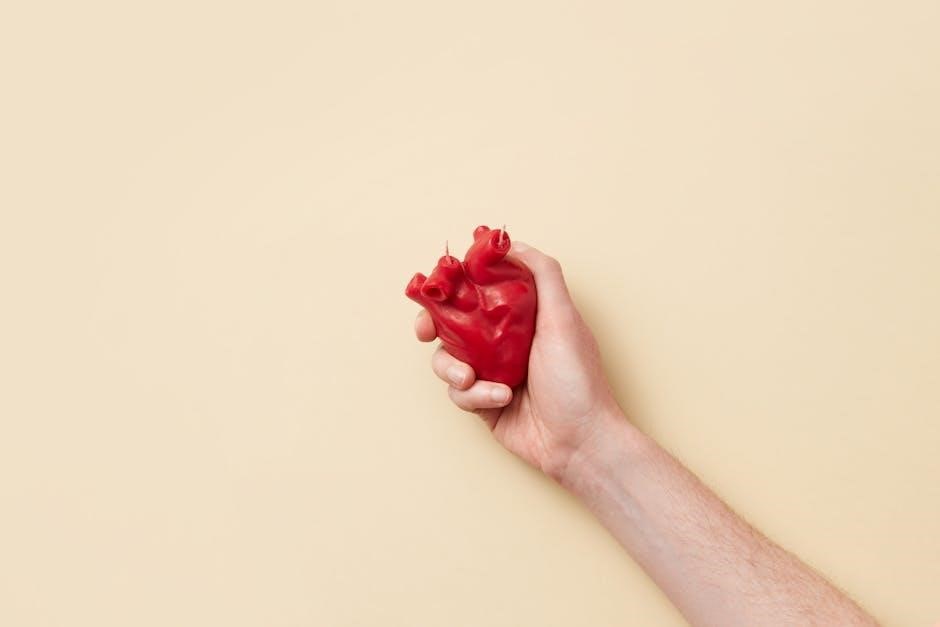The heart is a muscular organ central to the circulatory system, pumping blood throughout the body. Its anatomy includes chambers, valves, and vessels, enabling efficient blood circulation.
1.1 Definition and Overview
The heart is a muscular organ that serves as the core of the circulatory system, responsible for pumping blood throughout the body. It is a double pump with four chambers, ensuring efficient blood flow. Located between the lungs, the heart receives oxygen-depleted blood via the venae cavae and sends oxygen-rich blood through the aorta. Its structure includes chambers, valves, and a conduction system, enabling precise coordination of contractions. This organ is vital for delivering oxygen and nutrients to tissues and removing waste products, making it essential for survival. Understanding its anatomy is crucial for diagnosing and treating heart-related conditions.
1.2 Importance of the Heart in the Circulatory System
The heart is the central organ of the circulatory system, responsible for pumping blood to meet the body’s oxygen and nutrient demands. It ensures blood flows to tissues, organs, and cells, sustaining life. The heart’s rhythmic contractions maintain blood pressure and regulate circulation, adapting to physical activity or rest. Its failure disrupts oxygen delivery, leading to tissue damage and organ dysfunction. Thus, the heart’s proper function is vital for overall health, making it a critical focus in medical diagnostics and treatments aimed at preventing cardiovascular diseases and maintaining bodily homeostasis. Its role is indispensable for survival and optimal physiological function.
Structure of the Heart
The heart is a muscular organ with four chambers, valves, and blood vessels, designed to pump blood efficiently through the circulatory system.
2.1 Four Chambers of the Heart
The heart consists of four chambers: the left and right atria, and the left and right ventricles. The atria are upper chambers that receive blood returning to the heart, while the ventricles are lower, muscular chambers that pump blood out to the body and lungs. The septum, a thick wall of tissue, separates the left and right sides of the heart, preventing blood from mixing. This division ensures oxygen-rich and oxygen-poor blood flow through separate pathways, maintaining efficient circulation. The chambers work together to ensure blood is pumped effectively throughout the body.
2.2 Heart Valves and Their Functions
The heart contains four valves that regulate blood flow between its chambers. The tricuspid valve is located between the right atrium and ventricle, while the pulmonary valve is at the exit to the pulmonary artery. The mitral (bicuspid) valve separates the left atrium and ventricle, and the aortic valve is at the exit to the aorta. These valves ensure blood flows in one direction, preventing backflow. Proper valve function is crucial for maintaining efficient blood circulation. If valves malfunction, conditions like heart murmurs or reduced cardiac efficiency can occur, emphasizing their vital role in heart anatomy and function.
2.3 Blood Vessels Connected to the Heart
The heart is connected to several major blood vessels that facilitate blood circulation. The aorta, the largest artery, arises from the left ventricle, carrying oxygenated blood to the body. The pulmonary arteries transport deoxygenated blood from the right ventricle to the lungs, while the pulmonary veins return oxygenated blood to the left atrium. The coronary arteries, originating from the aorta, supply oxygenated blood to the heart muscle itself. Additionally, the superior and inferior vena cava bring deoxygenated blood from the body to the right atrium. These vessels are essential for maintaining systemic and pulmonary circulation, ensuring proper blood flow throughout the body.

Blood Flow Through the Heart
Blood flows into the heart through veins, entering the atria, then moves to the ventricles, and is pumped out through arteries, ensuring oxygenated blood circulates efficiently.
3.1 Pathway of Blood Through the Chambers
Blood enters the heart through the superior and inferior vena cava into the right atrium. It flows through the tricuspid valve into the right ventricle, then exits via the pulmonary artery to the lungs for oxygenation. Oxygen-rich blood returns through the pulmonary veins into the left atrium, passing through the mitral valve into the left ventricle. Finally, it is pumped out through the aortic valve into the aorta, distributing oxygenated blood throughout the body. This pathway ensures efficient circulation, separating oxygenated and deoxygenated blood flows.
3.2 Role of the Conduction System
The heart’s conduction system regulates its rhythmic contractions, ensuring synchronized blood flow. It starts with the sinoatrial node, the natural pacemaker, generating electrical impulses. These signals travel through the atria to the atrioventricular node, which delays and amplifies them. The impulses then race along the Bundle of His, dividing into the left and right bundle branches, stimulating the ventricles to contract. This system maintains a consistent heartbeat, adapting to physical demands by adjusting the heart rate through neural and hormonal controls, thus optimizing cardiac performance and overall circulation.

Heart Function and Physiology
The heart functions as a muscular pump, circulating blood throughout the body. Its physiology involves rhythmic contractions, adapting to physical demands to maintain optimal blood flow and oxygen delivery.
4.1 Cardiac Cycle and Heartbeat Regulation
The cardiac cycle consists of systole (contraction) and diastole (relaxation), enabling the heart to pump blood efficiently. Heartbeat regulation is controlled by the conduction system, including the SA node, AV node, bundle of His, and Purkinje fibers. These components ensure a coordinated and rhythmic heartbeat, maintaining cardiac rhythm and adapting to physiological demands. The autonomic nervous system further modulates heart rate, balancing sympathetic (increasing rate) and parasympathetic (decreasing rate) influences. This intricate regulation ensures optimal blood circulation under varying conditions, making the heart a highly adaptable organ.
4.2 Coronary Circulation and Heart Muscle Supply
The heart receives its blood supply through the coronary circulation, a network of arteries and veins. The right and left coronary arteries branch from the aorta, supplying oxygenated blood to the heart muscle. These arteries divide into smaller branches, ensuring all regions of the myocardium are nourished. Deoxygenated blood is collected by the coronary veins and returned to the coronary sinus, which empties into the right atrium. This dual circulation system prevents the heart from ischemia, maintaining its functionality and overall cardiovascular health.
Clinical Significance of Heart Anatomy
Understanding heart anatomy is crucial for diagnosing and treating heart diseases, such as coronary artery disease, heart failure, and congenital defects, improving patient outcomes and clinical decisions.
5.1 Common Heart Diseases and Disorders
The heart is susceptible to various diseases and disorders that affect its structure and function. Coronary artery disease, caused by plaque buildup in arteries, can lead to heart attacks. Heart failure occurs when the heart cannot pump blood efficiently. Valvular heart diseases, such as stenosis or regurgitation, disrupt blood flow. Arrhythmias, like atrial fibrillation, involve irregular heartbeats. Congenital heart defects, present at birth, include septal defects and abnormal valve formation. Hypertension and cardiomyopathy also pose significant risks. Early detection and treatment are crucial for managing these conditions and improving patient outcomes.
5.2 Diagnostic Methods for Heart Conditions
Diagnosing heart conditions involves various methods to assess cardiac health. An electrocardiogram (ECG) measures heart rhythm and detects irregularities. Echocardiograms use ultrasound to visualize heart structures and valve function. Stress tests evaluate heart performance under physical exertion. Cardiac catheterization and angiograms examine blood flow and artery blockages. Magnetic resonance imaging (MRI) and computed tomography (CT) scans provide detailed images of heart tissues. Blood tests can identify biomarkers for heart damage or inflammation. These diagnostic tools help identify conditions like coronary artery disease, heart failure, or arrhythmias, enabling timely and effective treatment plans.
External and Internal Anatomy
The heart’s external anatomy includes its shape, size, and location in the thoracic cavity. Internally, it features layers like the epicardium, myocardium, and endocardium, essential for its function.
6.1 Shape, Size, and Location of the Heart
The heart is a muscular organ with a shape resembling an inverted fist. It is approximately the size of a large fist and weighs about 250-300 grams in adults. Located in the thoracic cavity, it sits slightly to the left of the midline, behind the sternum, and between the lungs. The heart is enclosed by the pericardium, a protective sac that anchors it in place and allows for smooth movement during contractions. Its position and structure enable efficient blood circulation throughout the body, making it a vital component of the circulatory system.
6.2 Layers of the Heart Wall
The heart wall consists of three distinct layers: the epicardium, myocardium, and endocardium. The epicardium is the outermost layer, acting as a protective membrane. The myocardium, the thickest layer, is composed of cardiac muscle cells responsible for contraction. The endocardium lines the inner surfaces, including the heart chambers and valves, facilitating smooth blood flow. Together, these layers ensure the heart functions efficiently, maintaining its structure and enabling continuous blood circulation throughout the body.

Types of Circulation
The circulatory system operates through two main types: pulmonary and systemic circulation. Pulmonary circulation transports deoxygenated blood to the lungs, while systemic circulation supplies oxygenated blood to the body.
7.1 Pulmonary Circulation
Pulmonary circulation is the pathway by which deoxygenated blood flows from the heart to the lungs and oxygenated blood returns. It begins when the right ventricle pumps blood through the pulmonary artery to the lungs, where oxygen is absorbed and carbon dioxide is released. The oxygen-rich blood then travels back to the left atrium via the pulmonary veins. This system is crucial for gas exchange, ensuring the body’s tissues receive oxygenated blood while deoxygenated blood is replenished. Pulmonary circulation operates at lower pressure compared to systemic circulation, making it efficient for oxygenation. It is vital for maintaining respiratory and cardiovascular health.
7.2 Systemic Circulation
Systemic circulation is the pathway by which oxygenated blood is distributed from the heart to all body tissues and deoxygenated blood returns. It begins with the left ventricle pumping blood through the aorta, the largest artery, which branches into smaller arteries and arterioles. These deliver oxygenated blood to capillaries, where oxygen and nutrients diffuse into tissues. Deoxygenated blood collects in venules and veins, returning to the heart through the superior and inferior vena cava. This system maintains tissue oxygenation, supports cellular function, and removes waste products. It operates at higher pressure than pulmonary circulation, driven by the powerful left ventricle; Essential for overall bodily function and metabolism.

Developmental Anatomy of the Heart
The heart develops from embryonic tissue, forming chambers and valves. Any deviations can lead to congenital defects, emphasizing the complexity of its developmental process.
8.1 Embryological Development
The heart begins developing early in embryonic life, originating from splanchnic mesoderm. It forms a linear tube that folds and differentiates into four chambers. This complex process involves precise cellular signaling and morphogenetic events, ensuring the formation of a functional organ. Any disruptions can result in congenital heart defects, highlighting the critical nature of embryological development in heart anatomy.
8.2 Congenital Heart Defects
Congenital heart defects are abnormalities present at birth, arising from disruptions in embryological development. These defects can affect heart structure, such as septal defects or valve malformations, and may impact blood flow. Some defects are asymptomatic, while others require medical intervention. Advances in diagnostic methods and surgical techniques have improved outcomes for individuals with these conditions, emphasizing the importance of early detection and personalized treatment plans. Understanding these defects is crucial for managing cardiovascular health and preventing complications later in life.







